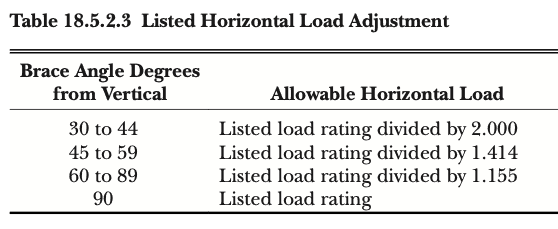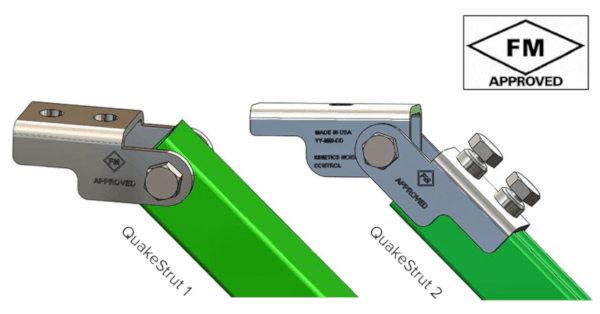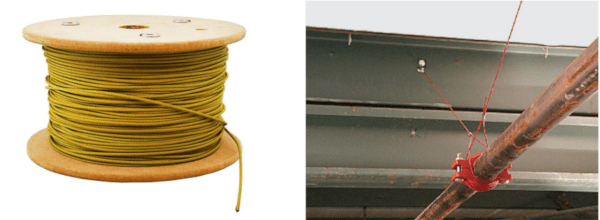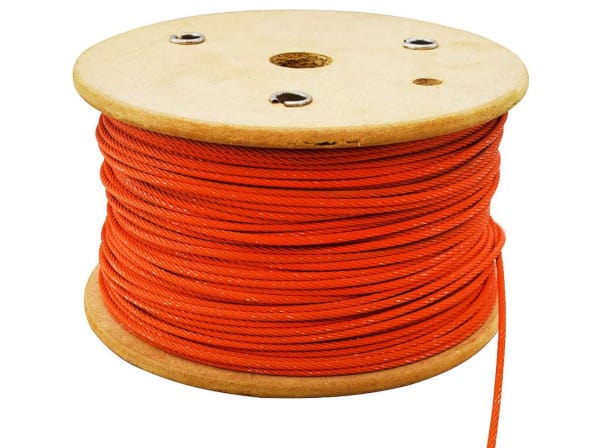The rigid seismic design achieved through seismic bracing prevents damage to vital infrastructure
Protecting the inner workings of a building from earthquakes is almost as important as protecting the building itself. Structural elements—columns, beams, walls, ceilings—keep the building standing. But the nonstructural “guts” make it useful. Electrical systems, plumbing, natural gas, HVAC, telecommunications equipment, and fire protection systems are all essential functions of a structure.
The National Fire Protection Association (NFPA), the International Building Code, and the American Society of Civil Engineers (ASCE) all require seismic protections for specific nonstructural elements. The failure of some of these components during an earthquake can cause serious financial damage as well as loss of life.
Protecting fire sprinkler systems from earthquakes is particularly crucial for several reasons. These systems are not exactly cheap—and if they break, you may be stuck not only paying for repairs to the system but also cleaning up water damage while losing the use of the building. And earthquakes bring an elevated fire risk. Gas lines break, wires are exposed—it’s a really bad time to be without working fire sprinklers.
NFPA provides guidelines for the protection of fire sprinkler systems against earthquakes. Chapter 18 of NFPA 13: Standard for the Installation of Fire Sprinkler Systems (2019 edition) explains how seismic protections for fire sprinkler systems should be installed when they are needed. The technologies described in NFPA 13 counter the following sources of damage in earthquakes:
- Differential movement: when buildings (or different parts of one building) move differently, causing pipes to separate, bend, twist, slam, or otherwise sustain damage.
- Inertial forces: when the shaking of buildings causes pipe to shake relative to the building, stressing pipe hangers and the pipes themselves.
In Part 1 of this series, we dug into how the seismic design principle of flexibility—via flexible couplings, seismic separation assemblies, or simple clearance—prevents damage from differential movement.
In this article, we look in the opposite direction. Instead of making things more flexible, you can protect fire sprinkler systems from earthquakes by making certain components more rigid. This is accomplished through seismic bracing of fire sprinkler systems.
Seismic bracing protects building components from shaking
As a building moves during an earthquake, nonstructural components can experience strong inertial forces. In other words, they shake and sway violently, sustaining damage and potentially failing.
The solution is rigidity. To prevent nonstructural components from shaking and swaying relative to the building, they are firmly attached to structural components that are expected to move as a unit during an earthquake.
For example, a pipe suspended from the ceiling might receive extra supports so that it always moves with the ceiling during an earthquake. This technique is known as seismic bracing, or sway bracing.
Fire sprinkler systems are particularly vulnerable to shake damage. Aside from the damage to the pipes themselves (which is a serious concern), shaking during an earthquake significantly stresses pipe hangers. As detailed in Chapter 17 of NFPA 13, fire sprinkler risers, main lines, and branch lines are hung from or otherwise secured to structural members. The hardware used to do this includes:
- Anchors are driven into steel, concrete, or wood, and threaded to accept hanger rods.
- Top-beam clamps attach a pipe to structural steel beams without drilling, and they are threaded to accept hanger rods.
- Hanger rods.
- Pipe hanger rings support pipe.
- Riser clamps support risers.
Because this hardware that is attached to structural members is vulnerable during an earthquake, section 18.5 of NFPA 13 requires seismic bracing for fire sprinkler risers, main lines, and branch lines 2.5 inches or larger if the building falls into a certain seismic design category. Pipe smaller than these areas is generally more flexible and requires only vertical restraint rather than bracing.
The principles of seismic bracing
Seismic bracing resists horizontal motion. Braces are installed to resist both lateral (perpendicular to the pipe) and longitudinal (parallel to the pipe) swaying. Vertical motion is not usually a concern.
As the NFPA 13 Handbook explains, “vertical lift forces are generally expected to be offset by gravity, and vertical downward forces are expected to be handled within normal safety factors of system hangers.” Some exceptions to this—involving strong horizontal forces and low-angle bracing—are covered in section 18.5.10 of NFPA 13.
Seismic braces, like pipe hangers, must be attached to the building structure so that fire sprinkler pipe and other nonstructural components can move as a unit with the building. Per NFPA 13, 18.5.1.2, the structural members to which seismic braces are mounted must be able to withstand the anticipated seismic forces. Section 18.5.1.4 adds that where seismic braces are fixed to the same structural members from which pipes are hung, the member must be able to handle the combined gravity and seismic loads it will experience.
The NFPA 13 Handbook also states that the top of the system riser, all feed and cross mains, and branch lines 2.5” or greater in diameter must be braced against lateral (perpendicular to the pipe) and longitudinal (parallel to the pipe) motion.
The characteristics of equipment
The components of seismic bracing assemblies must be made of ferrous material (18.5.3.1). Nonferrous materials are permitted when the components are specifically listed and approved for this purpose (18.5.3.2). Listing and approval come from third-party safety testing organizations like UL (formerly Underwriter’s Laboratory) or FM Global.
The entire sway bracing assembly must be listed for the maximum seismic load (18.5.2.1), including the hardware fastening the braces to the structure and the pipes. Note that the maximum horizontal load varies with the brace angle. The further from vertical the brace is angled, the more horizontal force it and its hardware can sustain. This should be intuitive; a totally vertical brace assembly sustains the same amount of torque as a pipe hanger assembly. If the manufacturer’s datasheet does not state the maximum allowable loads at angles other than horizontal (90° from vertical), Table 18.5.2.3 describes how to calculate the load at an angle:

There is an exception (18.5.2.2) to the listing requirement for braces. Some standard steel materials (like schedule 40 pipe, angles, flats, all-thread rod, and end-thread rod) do not need to be listed because their properties are known. The maximum horizontal loads of different dimensions of different materials in different conditions can be determined from tables 18.5.11.8 (a-f) in NFPA 13.
There are two kinds of seismic braces: rigid braces and cable (tension-only) braces. Both rigid and cable braces counter swaying motion by strongly attaching pipe to structural members of the building.
Rigid seismic bracing
Rigid bracing is, as the name indicates, a stiff and unbending piece of equipment. These braces are almost always comprised of steel. The core advantage of this stiff bracing is that it resists motion in two directions (through compression and tension). The big disadvantage of rigid bracing goes along with its advantage: a rigid length of steel has to be cut to the proper length to run from the structural anchor point to its attachment at the pipes.

For easier installation, rigid brace systems often use hinged attachments. The attachments bolt into both the structure and the nonstructural equipment. Pivot points where the attachments connect to the brace member allow them to be easily placed at the correct angle. Note that all bolts and screws used to mount rigid braces must be listed and approved for the purpose and seismic load.
Seismic cable bracing
Seismic cable bracing is made of steel cable that’s listed for use as seismic bracing. Since it’s somewhat flexible, it resists motion in only one direction, and it is sometimes referred to as “tension bracing” for this reason. This means that to do the same job as a stiff brace, two seismic cable braces are needed. But cable bracing has a huge advantage over rigid bracing: it’s basically unlimited in length, and it can be easily cut to fit any space.
Seismic cable bracing cannot be made of just any steel cable. Per section 18.5.4.2 of NFPA 13, tension-only braces are allowed only when they are listed for the purpose and the seismic loads do not exceed their listed capabilities.
The allowable load of seismic cable is color-coded with the following scheme:
- Gold—418 lb. load
- Orange—770 lb. load
- Green—1,900 lb. load
- Black—3,180 lb. load

Always follow the manufacturer’s instructions when installing seismic cable bracing. But the installation process is generally as follows:
- An anchoring fitting is secured to the structure with a bolt or screw. Fittings, bolts, and screws must be listed and approved for the seismic load. Fittings are listed for the color of cable they accept without reducing breaking strength.
- Bracing cable is threaded through the attachment holes on the anchor. A sleeve that fits over the ends of the cable—after crimping it with a hand swager (gauged for different colors of cable)—holds it in place.
The cable is looped around the fire sprinkler pipe and again secured by crimping it with a hand swager.
Restraint of branch lines
The branch lines of fire sprinkler systems, although more flexible than other pipes, require restraint against horizontal and vertical movement to prevent damage from a collision with surrounding objects. As the NFPA 13 Handbook (18.6) explains, restraint of branch lines does not need to be as extensive as the bracing of larger piping. Restraint of branch lines can be accomplished in the following ways:
- With “a listed sway brace assembly”
- With “a wrap-around U-hook”
- With No. 12 440 lb. wire
- With CPVC pipe hangers listed for the purpose or with other hangers installed according to the requirements of section 6.1(5) of NFPA 13
Section 18.6.2 of NFPA 13 details the installation and spacing requirements for wire restraint.
Seismic bracing and flexible design protect fire sprinklers from earthquakes
Fire sprinkler systems provide vital protection for buildings. Earthquakes increase the risk of fire, so the failure of fire sprinklers during and after seismic events opens a structure up to serious risk. And repairing a fire sprinkler system and cleaning up any associated damage is expensive.
Thankfully, seismic bracing allows fire sprinkler pipe and other nonstructural elements to move with the building, often preventing damage caused by shaking and swaying.
But earthquakes move buildings—and the nonstructural equipment in them—in three dimensions. And this varying movement strains and damages all nonstructural elements in two ways: differential movement as well as shaking.
Go back and read Part 1 of this series to learn about the principles and technologies involved in flexible seismic design—the primary way that fire sprinkler systems and other infrastructure are protected from differential movement.
Looking for more on code requirements for seismic bracing? Read our deep-dive into NFPA 13 Seismic Bracing Requirements with a focus on cable sway braces.
This blog was originally posted at blog.qrfs.com. Check us out at Facebook.com/QuickResponseFireSupply or on Twitter @QuickResponseFS.


